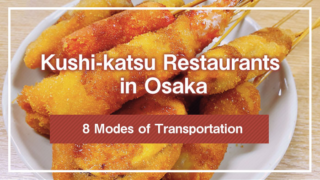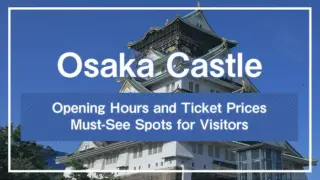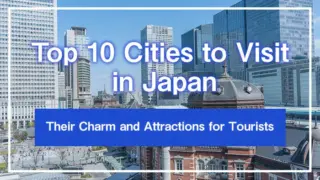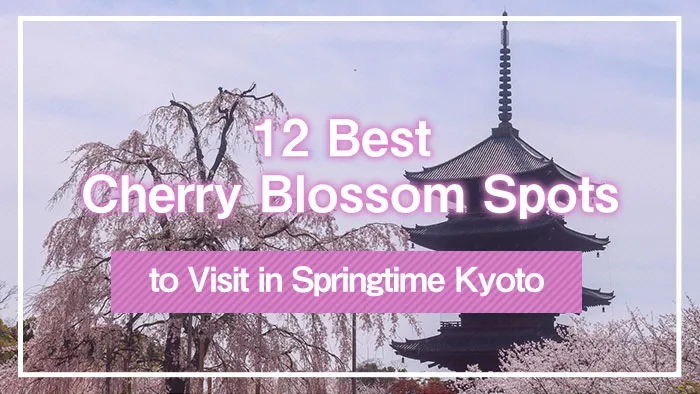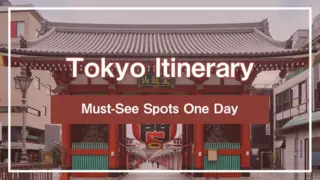Kyoto is a popular tourist destination all year round, but it attracts the most visitors from late March to early April when the cherry blossoms are in full bloom. You can see a variety of cherry blossoms throughout the city, from the soft pink “Somei Yoshino” to the deeper pink “Yamazakura,” and the weeping branches of the “Shidarezakura.”
This article introduces 12 must-visit cherry blossom spots in Kyoto for your spring trip.
1.Cherry Blossom Spots at Kyoto’s Temples and Shrines
Kyoto is home to countless cherry blossom spots. When you visit, it’s highly recommended to enjoy the stunning views of cherry blossoms alongside temples and shrines.The harmony between the historical landscapes and the vibrant cherry blossoms is a unique sight that can only be experienced in Kyoto. The combination of Japan’s proud cherry blossoms and historical buildings creates a breathtaking view. Some of the cherry blossom spots are also illuminated at night, offering a different and enchanting view compared to the daytime.
Below, we introduce cherry blossom spots at temples and shrines in Kyoto. We will also describe the characteristics and attractions of each spot, so be sure to use this as a reference when you visit.
1-1.Heian Shrine
Heian Shrine is a classic spot where the beautiful red weeping cherry blossoms bloom. The weeping cherry blossoms begin blooming in early April, after the Somei Yoshino cherry blossoms have fallen. The combination of the shrine’s vermilion buildings and the pink cherry blossoms creates an unforgettable view. About 300 cherry trees bloom in the shrine grounds, which can be visited for free, but entering the garden requires an admission fee of 600 yen for adults.
1-2.To-ji Temple
To-ji Temple is famous for its “Fuji Sakura,” a type of double-flowered weeping cherry blossom. About 200 cherry trees bloom here, attracting many visitors.
Fuji Sakura originates from Morioka City in Iwate Prefecture, one of the areas affected by the Great East Japan Earthquake in 2011. During the cherry blossom season, a special spring event is held to pray for the affected Tohoku region, and the cherry blossoms are illuminated at night. The sight of To-ji Temple and Fuji Sakura illuminated at night, reflecting in the pond, is a must-see.
The admission fee is 1,000 yen for adults and high school students, and 500 yen for junior high school students and younger.
1-3. Daigo-ji Temple
Daigo-ji Temple is a famous spot where about 700 cherry trees, including Somei Yoshino, Yaezakura, and weeping cherry blossoms, bloom. This historic site is where Toyotomi Hideyoshi held the famous “Daigo no Hanami” (Hanami at Daigo) cherry blossom viewing. Following this tradition, the “Toyotomi Hideyoshi Cherry Blossom Parade” is held every year on the second Sunday of April, and attracts many viewers.
The admission fee for the Reihokan Garden, Garan, and Sanboin Garden is 1,000 yen for adults and 700 yen for junior high and high school students. From March 20 to Golden Week, special spring admission fees are 1,500 yen for adults and 1,000 yen for junior high and high school students. The admission fee for Upper Daigo is 600 yen for adults and 400 yen for junior high and high school students.
1-4.Ninna-ji Temple
Ninna-ji Temple has been famous for its cherry blossoms since the Edo period. About 200 cherry trees, mainly of the Omuro Ariake variety, bloom here. The cherry trees at Ninna-ji Temple are relatively low in height at about 3 meters tall, allowing visitors to enjoy them up close. They also bloom later in the season, and the view of the five-story pagoda rising above a sea of cherry blossoms is spectacular.
Admission is usually free, but during the Omuro Cherry Blossom Festival, an admission fee of 500 yen is charged.
1-5.Nijo Castle
Nijo Castle is home to about 300 cherry trees of around 50 different varieties. Various types of cherry blossoms,including Somei Yoshino, Sato Zakura, and Yama Zakura, bloom from late March, creating a beautiful landscape for about a month. At night, the cherry blossoms and historical buildings are illuminated, presenting a stunning sight.
Built by Tokugawa Ieyasu, Nijo Castle’s historical depth can be felt when you see it in person. The admission fee is 1,300 yen for adults, 400 yen for junior high and high school students, and 300 yen for elementary school students. During the cherry blossom season, festivals are held with quiz rallies and cultural experience events.
1-6.Chion-in Temple
Chion-in Temple is a cherry blossom spot where more than 200 cherry trees bloom within its grounds.In the Yuzen Garden and Hojo Garden, you can see beautiful large weeping cherry trees. At night, the cherry blossoms are illuminated, creating an extraordinary view.
The admission fee for Yuzen Garden is 300 yen for adults and 150 yen for elementary and junior high school students. Hojo Garden’s admission fee is 400 yen for adults and 200 yen for elementary and junior high school students. To see the illuminated cherry blossoms, the fee is 800 yen for adults and 400 yen for elementary and junior high school students.
2.Cherry Blossom Spots Along Kyoto’s Rivers and in Parks
Kyoto also boasts numerous cherry blossom spots along rivers and in parks, making them easy stops during your travels. These locations are great for taking a break while enjoying the beautiful cherry blossoms. Below, we introduce some of the best riverside and park locations in Kyoto where you can enjoy cherry blossoms. If you’re looking to enjoy the beautiful sakura scenery in a casual setting, these spots are a must visit.
2-1.Kamo River
The Kamo River, which flows through the center of Kyoto, features an approximately 840 meter long walking path lined with cherry trees, including the red double-flowered weeping cherry blossoms. During peak bloom, the path creates a tunnel of cherry blossoms, attracting many visitors.
On the opposite side of the path, you can find Somei Yoshino cherry trees, which offer a delightful contrast between the different types of cherry blossoms. From Kitayama Bridge to Kitaoji Bridge, about 70 cherry trees are in full bloom.
2-2.Philosopher’s Path
The Philosopher’s Path is a walkway stretching from Kumano Nyakuoji Shrine to Ginkaku-ji Temple. It is named after a famous Japanese philosopher who used to comtemplate while walking along this path. Selected as one of Japan’s 100 most beautiful streets, it features about 450 cherry trees along its approximately 2 km path.
The cherry trees, mostly Somei Yoshino, create an enchanting tunnel of blossoms in early April each year. The sight of cherry blossoms reflecting on the water surface, as well as the fallen petals floating on the water, adds to the charm. The Ginkakuji Bridge, located at the start of the path leading to Ginkaku-ji Temple, is a particularly popular tourist spot.
World Heritage Site Ginkaku-ji: History, Must-See Spots, and How to Get There
2-3.Maruyama Park
Maruyama Park is a large park located next to famous temples and shrines such as Chion-in Temple and Yasaka Shrine. It is also a perfect spot to relax with numerous tea houses and restaurants. About 680 cherry trees are planted in Maruyama Park, with the most famous being the Gion Weeping Cherry Tree in the center of the park.
The Gion Weeping Cherry Tree is one of the most well-known cherry trees in Kyoto, and it is highly recommended to see it when you visit Kyoto. It blooms about three days earlier than Somei Yoshino and reaches full bloom in early April. During certain periods, bonfires are lit to beautifully illuminate the tree, enhancing its charm with the natural light of the fire.
2-4. Keage Incline
The Keage Incline is the remains of an inclined railway that was used to transport boats. It was in operation until 1948 and is now a designated cultural property of Kyoto City with historical significance.
In early April, about 90 cherry trees, including Somei Yoshino and Yamazakura, bloom along the old railway tracks. The unique experience of walking along the now-unused tracks while enjoying the cherry blossoms is a special feature of the Keage Incline.The combination of the old railway tracks and the vibrant cherry blossoms creates a nostalgic charm.
2-5. Kyoto Gyoen National Garden
Kyoto Gyoen National Garden is a vast cherry blossom spot located in the heart of Kyoto. It features about 1,000 cherry trees, including Satozakura and weeping cherry trees, drawing large crowds in the spring. With its historical buildings, rest areas, and sports facilities, it is a beloved spot for tourists and locals alike.
2-6.Arashiyama
Arashiyama’s Togetsukyo Bridge is a renowned cherry blossom spot with about 1,500 cherry trees, mainly Somei Yoshino. The area is named “Arashiyama” (Storm Mountain) because the cherry blossoms and autumn leaves appear to flutter down like a storm. It is truly fitting to call it a cherry blossom haven.
Togetsukyo Bridge is listed among Japan’s top 100 cherry blossom spots and attracts many visitors, including families, friends, and couples, who come to see the beautiful cherry trees lining the bridge every year.
During the cherry blossom season, it’s also recommended to take the “Night Sakura Train” on the Randen Line. The train slows down and turns off its lights as it passes through the cherry blossom tunnel between Narutaki and Utano stations, allowing passengers to fully appreciate the view of the cherry blossoms from the windows.
Conclusion
Kyoto offers numerous cherry blossom spots, each with its own unique types of cherry blossoms and beautiful landscapes. The harmony between Japan’s history and cherry blossoms is a luxurious experience exclusive to spring.
The cherry blossom spots introduced in this article are just a few of the many in Kyoto. Cherry trees are planted throughout the city, allowing you to enjoy cherry blossoms even during your regular sightseeing. You’re sure to discover your own favorite cherry blossom spots as you explore Kyoto.
*This article is based on information available as of May 2024.



